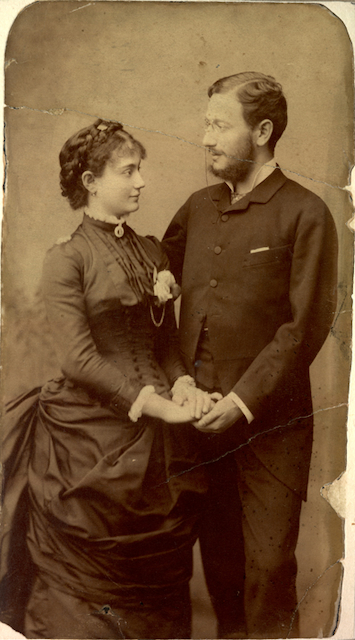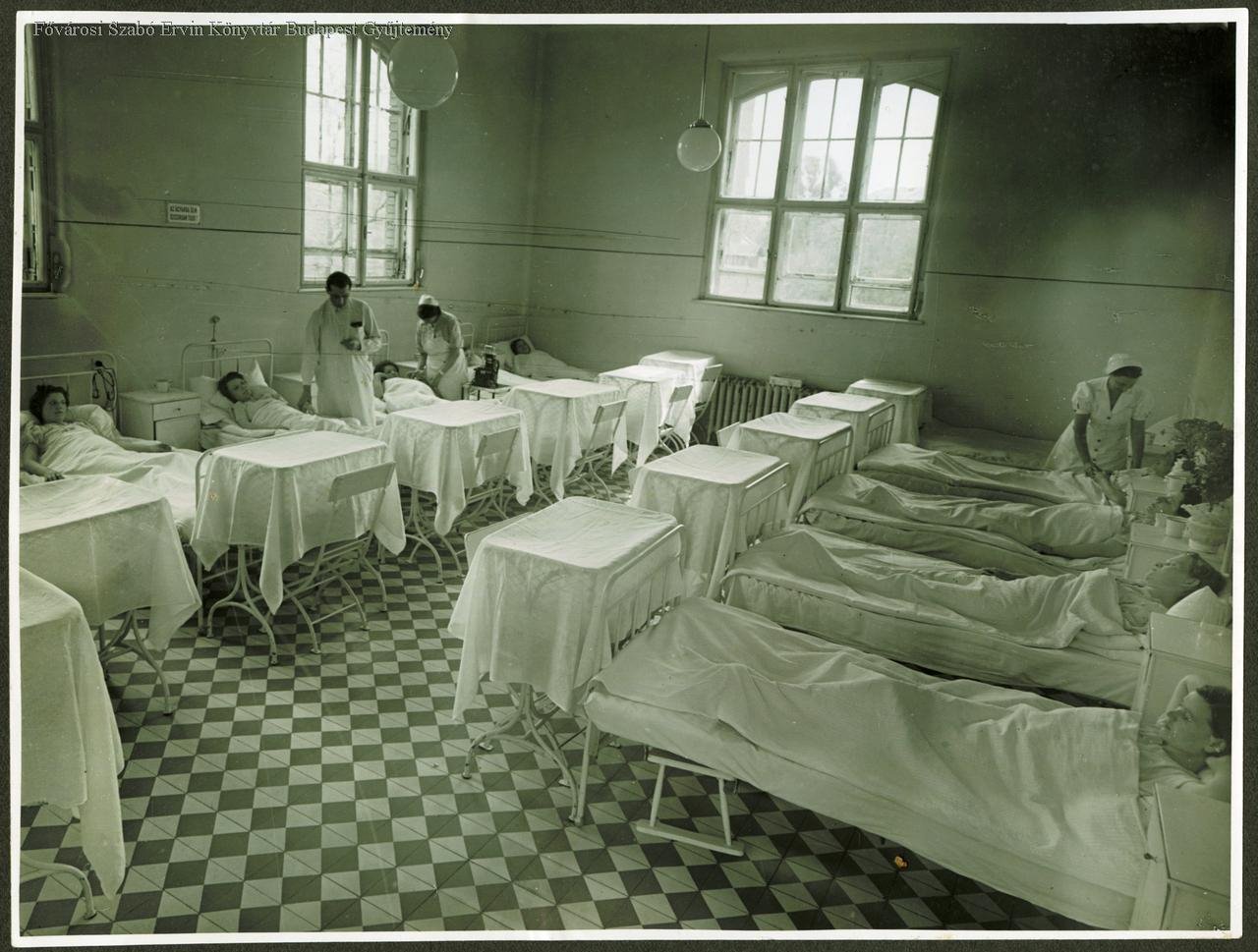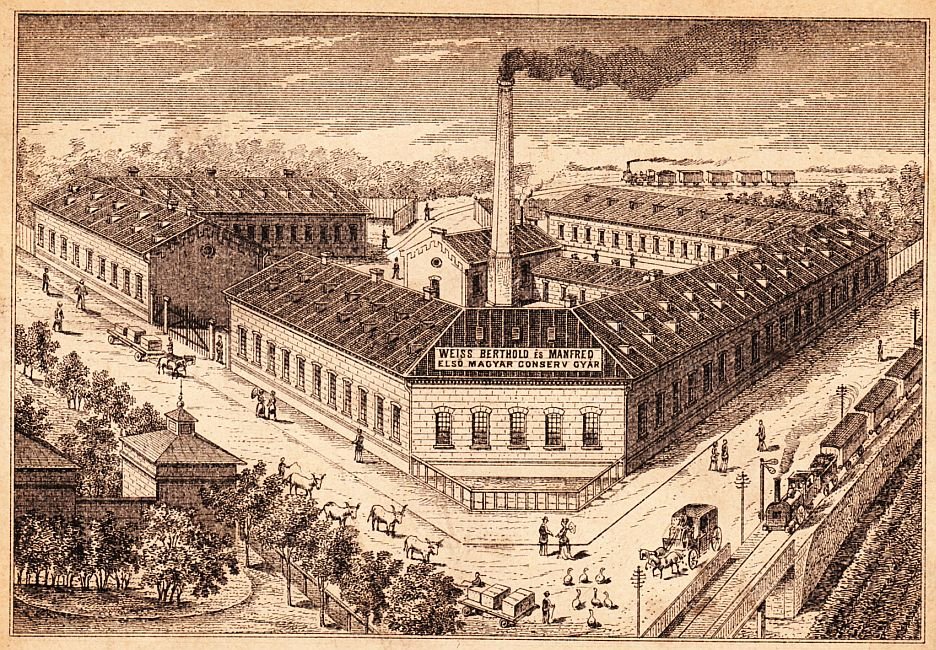Manfréd Weiss and his brother Berthold built the huge Weiss Works in Csepel thanks to their own idea. The big idea was canned meat, marketed as Globus and primarily supplied to the military. As they were suppliers to the army, they took advantage of this relationship. In addition to canned meat production, the Weiss brothers also undertook the renovation of old military ammunition at this time. What the military always needs is food and ammunition, success was a given. Of course, this product range was later joined by other products, such as the mobile camp kitchen, which became incredibly popular. Thanks to this, by 1922 the small plant had become a giant factory in Csepel.

Photo of Manfréd Weiss and his bride, Alice von Wahl in 1885 (Photo: Hungarian National Museum, Historical Photo Gallery, inventory number: 93.930)
The newspaper Népszava, which functioned as the journal of the Social Democratic Party of Hungary, therefore was neither a supporter of capitalism nor the ruling system, wrote this about Manfréd Weiss on 28 December 1922:
"Manfréd Weiss was a modern capitalist in the sense that, within the boundaries drawn by capitalist management, he understood the aspects of the workforce in matters of the employment relationship, not with power and aloof arrogance, but rationally. (…) Manfréd Weiss did not think that the issue of the workers was settled with wages — we must emphasise the exceptional nature of this on the part of all kinds of Hungarian big tycoons. The maternity home, the pulmonary sanatorium, the children's home and nursery are his valuable creations."
Manfréd Weiss was born in Pest in 1857, graduated from a commercial academy, and spent his apprenticeship in a colonial trading house in Hamburg. His ability and exceptional talent are clearly shown by the fact that he became the company manager of the trading house at the age of 20. But then, in 1877, he returned home because his father fell ill. Together with his brother Bertold, they entered the canning business in 1882, their factory was called "Berthold and Manfréd Weiss First Hungarian Conserv Company" and it was not yet operating in Csepel, but in Lövölde Square.

The cannery, still on Lövölde Square
But they soon moved to the area of the Közvágóhíd, and here they also produced the metal cans themselves. Since the technology of can and ammunition production was similar, the free capacities were filled by refurbishing the army's old infantry ammunition.
The fact that the Weiss factories moved to Csepel was the result of an accident, because in 1890 there was an explosion in the cartridge production department, as a result of which the authorities ordered the relocation of ammunition production. At that time, the choice was made for the uninhabited area in the northern part of Csepel, where the Weiss Manfréd Ammunition Factory began production in 1892, and in the future, production was increasingly concentrated in the Csepel area. The company continued to grow and expand both in the fields of canning and ammunition production, and more and more plant units were created to support production, including, for example, a steel and copper smelter, a forge, a rolling mill, warehouses and other buildings. The product range was also expanded, in 1901, for example, they began producing mobile, towable camp kitchens also for the military.

People waiting for food in front of the Manfréd Weiss soup kitchen on 30 August 1914 (Photo: Fortepan, National Széchényi Library)
The ever-growing factory meant enormous wealth to Manfréd Weiss (Bertold entered politics in 1896, and the management of the factory, therefore, fell to Manfréd alone), who - as was revealed in the Népszava article - also cared about the interests of the workers, supported charities, the poor, built hospitals, nurseries, modern workers' apartments, and this activity only increased during the war, especially donating a lot to healthcare purposes.
His financial situation is well illustrated by the fact that in 1917 he paid taxes of 34 million korona (equivalent to 19.4 billion HUF today), i.e., he was able to dispose of incredible sums. It is no wonder, since the huge factory reached its peak during World War I because the army required huge supplies, and the work already took place in three shifts, in 1917, for example, 330 million pieces of ammunition were delivered to the military, but at that time other products, such as aeroplanes were also made in the Csepel plant. The fighting was still in full swing when they were already planning the transition to peacetime production, so they were able to switch relatively quickly after the war, producing plough irons, sewing machines, bicycles, and then motorcycles and tractors as well.

The Csepel factory on a contemporary postcard
The Hungarian Soviet Republic was a big blow to Manfréd Weiss's life, because the Soviet system nationalised the factory, and seeing the destruction, he attempted suicide, took poison, and it was not until 1920 that he recovered enough to be able to return home from his treatment in Vienna. However, he lived only two years after that, because he suffered a stroke in November 1922 and died on 25 December 1922, after 40 days of suffering, at 6 p.m. Although he was born into a rich merchant family, what he achieved was unparalleled in his kind, since he built a huge factory complex from scratch and became one of the richest Hungarians who ever lived.

Fokker C. V type aeroplanes produced at the Manfréd Weiss factory in 1917 (Photo: Fortepan/Nr.: 57933)
This success and his significant social responsibility were recognised by the state and the Hungarian kings, Manfréd Weiss not only became the head, member, and president of many bodies and organisations, but in 1896 he received nobility from Franz Joseph - with the first name Csepel, and in 1916 he became a member of the House of Magnates, then he received the title of baron from Charles IV in 1918. Meanwhile, in 1901, following the success of the previous year's World Exhibition in Paris, he was awarded the Order of the Iron Crown, and in recognition of his achievements in the field of military development, he was also appointed Commander of the Order of Franz Joseph. Nevertheless, he remained a puritan, God-fearing man who cared about the factory and the people. It is no wonder that his funeral was a real large-scale commemoration, not only the domestic elite but also the working class mourned him. The already cited Népszava article ends with the following lines:
"The committee of the workers' organisations in Csepel stated in its Wednesday morning meeting that all the workers of Manfréd Weiss works who do not work on Thursday morning will attend the funeral. Gathering at 11 a.m. at the funeral home at 116 Andrássy Avenue."

Governor Miklós Horthy and Manfréd Weiss (Photo: Hungarian National Museum, Historical Photo Gallery, inventory number: 96,216)
A total of 4,000 people from the Csepel factories alone came to the Andrássy Avenue villa, but of course representatives of the government and the top ten thousand also showed up. The report of the 8 Órai Ujság on 29 December 1922 listed at length the nobles who appeared at the previous day's funeral, among whom it mentioned the following people first:
"There we saw Archduke Joseph Francis accompanied by General Sándor Álgya-Papp. Minister of Trade Lajos Walkó, State Secretary Dr István Bárczy, representing the government, former Prime Minister László Lukács, Baron Samu Hazai, retired Minister of National Defence, Baron József Szterényi, former Minister of Trade, Count Emil Széchenyi, Chief Rabbi Simon Hevesi, Dr Kornél Tolnay, former president of MÁV, Károly Némethy, former State Secretary, Ferenc Heinrich, former Minister of Trade."
The funeral ceremony was, of course, led by chief rabbi Simon Hevesi, "with bright clerical assistance", according to the article cited above. The newspaper described the funeral as follows:
"After the eulogies and prayers were said, the coffin and wreaths were placed on the hearse waiting in front of the villa and the procession started on Andrássy Avenue, Felső Erdősor Street, Köztemetői Road to the Israeli cemetery on Kerepesi Street. A huge crowd followed the coffin, and around 6,000 people marched along Andrássy Avenue, all the way to the cemetery gate. After a short prayer in the cemetery, Manfréd Weiss was laid to rest in the family tomb. During the funeral ceremony, work in all factories in and around Budapest was suspended for half an hour as a sign of mourning."

One of the older wards of the Csepeli Weiss Alice Maternity Home in 1941. The home was founded by Manfréd Weiss in memory of his wife, who died in 1904 (Photo: FSZEK Budapest Collection)
With the death of Manfréd Weiss, the huge empire did not fall apart, it was held together by the eight heirs, the leadership was continued by Manfréd Weiss' two sons-in-law, Ferenc Chorin and Móric Kornfeld. The factory, therefore, continued to serve the country until, during World War II, the occupying Germans, specifically the SS, took over the factory as a condition for the family's departure to Switzerland. When the Germans retreated, they took everything that could be moved. After the war, in 1946, the factory came under state supervision, and then in 1948, it was nationalised, from 1950 it was called Mátyás Rákosi Steel and Metal Works, and from 1956 it was called Csepel Steel and Metal Works.
The Csepel Steel and Metal Works Trust was dissolved by the Council of Ministers on 30 June 1983, because it had not been able to repay the loans taken out for years and had no chance of recovering from the crisis. Independent companies were then created from its units and tried to meet the increasingly difficult market challenges.
Cover photo: View of Manfréd Weiss and Bertold's first plant at Lövölde Square (Wikipedia)




































Hozzászólások
Log in or register to comment!
Login Registration